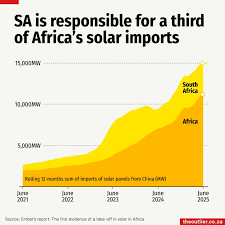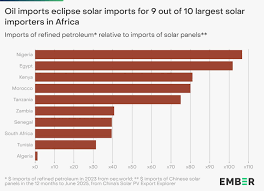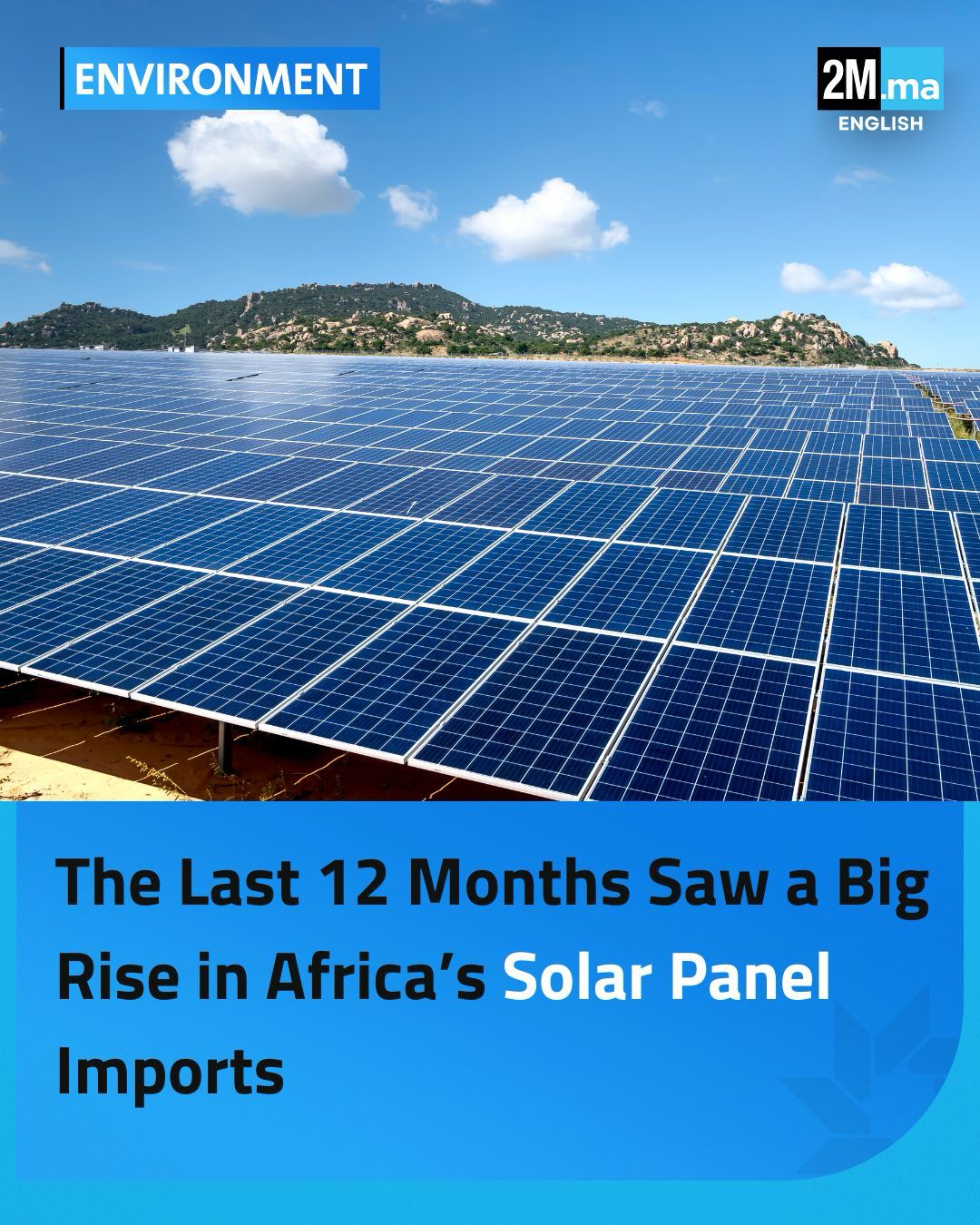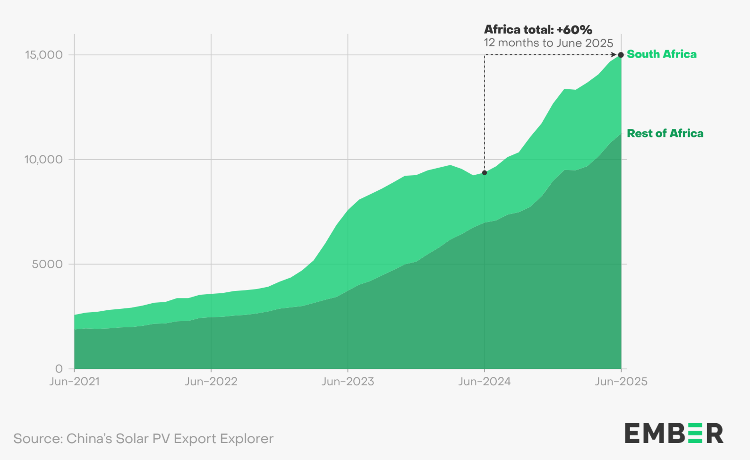Africa’s Solar Revolution Is Finally Here,solar imports have risen by 60 percent in 2025
For years, experts have predicted that Africa would become the next big frontier for solar energy. That moment may finally be here.
According to new data analyzed by Ember, the continent has seen a massive 60% increase in solar panel imports from China over the past 12 months—rising to 15,032 MW of new capacity by mid-2025. This unprecedented growth represents the first clear evidence of a continent-wide solar take-off that could reshape Africa’s energy landscape.
Solar is no stranger to Africa. For decades, small-scale systems have powered rural schools, hospitals, streetlights, boreholes, and mini-grids. But until recently, large-scale deployment was concentrated in South Africa and Egypt, the only countries with gigawatt-level capacity. Now, the data shows that’s rapidly changing.
 📈 Solar Imports Across Africa Are Skyrocketing
📈 Solar Imports Across Africa Are Skyrocketing
Between mid-2024 and mid-2025, 20 African countries set new solar import records, and 25 imported at least 100 MW—up from just 15 countries the year before.
The biggest importers were South Africa, Nigeria, and Algeria, with strong growth also seen in Zambia, Botswana, Sudan, Liberia, Benin, Angola, and Ethiopia. Algeria’s imports alone increased 33-fold in a single year.
Even more significant: imports outside South Africa nearly tripled in two years, from 3,734 MW in 2023 to 11,248 MW in 2025.
This means that for the first time, solar energy growth in Africa is becoming broad-based and pan-continental, not just concentrated in a few leading economies.
☀️ What This Means for Electricity Generation
If installed, the panels imported in just the past year could transform national energy balances.
- In Sierra Leone, imported solar capacity could generate electricity equal to 61% of total 2023 generation.
- In Chad, it could cover 49%.
- In Liberia, Somalia, Eritrea, Togo, and Benin, solar could add between 10–25% to existing power output.
Altogether, 16 African nations could see an increase of at least 5% in total generation—an extraordinary leap for a single year’s imports.
Although Africa as a whole remains at just 2% growth (due to the large size of South Africa and Egypt’s grids), the momentum is clearly building.
 ⛽ From Diesel Dependency to Solar Independence
⛽ From Diesel Dependency to Solar Independence
One of the most powerful impacts of this solar surge is the reduction in fuel imports.
In nine of Africa’s ten biggest solar importers, the value of refined petroleum imports still outweighs solar panel imports by 30 to 107 times. Yet this imbalance may soon start to change.Solar systems pay for themselves quickly in Africa’s high-fuel-cost economies. For example:
- In Nigeria, a 420-watt solar panel costs about $60 and can generate 550 kWh per year.
- Producing the same amount of power with diesel would cost roughly $120, given current fuel prices.
That means the payback period for solar in Nigeria is less than six months—and even shorter in other African nations where diesel prices are higher.
Beyond savings, solar power offers energy security, cleaner air, and economic empowerment. For communities long reliant on unstable grids and expensive generators, distributed solar systems are delivering freedom and reliability.
⚡ Distributed Solar Is Leading the Charge
While utility-scale projects are still limited in number, early evidence suggests that much of this growth is being driven by distributed solar—systems installed on homes, shops, offices, churches, and small factories.
Across Africa’s cities, from Lagos to Monrovia, rooftops are increasingly dotted with PV panels. These small systems, often installed off-grid, are quietly revolutionizing access to clean energy and helping businesses operate through power outages.
This mirrors the pattern seen in Pakistan, which witnessed one of the world’s fastest solar booms. In just a year, Pakistan tripled its solar imports, driven largely by rooftop installations responding to high electricity costs and frequent blackouts. Africa’s conditions are remarkably similar—sun-rich, energy-poor, and hungry for independence.
🏭 Africa’s Solar Manufacturing Is Still Nascent
At present, most of Africa’s solar panels are imported from China, which produced 80% of the world’s supply in 2024.
However, local manufacturing capacity is slowly emerging.
- Morocco now produces about 1 GW of panels per year.
- South Africa has similar capacity.
- Egypt has three major new factories in the pipeline, including EliTe Solar (3 GW in 2025), Sunrev Solar (2 GW in 2026), and Masdar (4 GW).
These projects mark the beginning of a local value-chain evolution, which could generate thousands of green jobs while reducing reliance on imports over the next decade.
🧭 Tracking the Solar Transformation
Data from China’s customs authority (GACC) provides the most complete real-time picture of Africa’s solar growth. Ember’s China Solar Export Explorer updates monthly, offering insights into which countries are scaling fastest.
However, import data only tells part of the story. Solar panels may take months to ship, clear customs, and be installed. Some are stored in warehouses, while others are re-exported to neighboring countries.
To truly understand Africa’s solar rise, researchers and policymakers must combine import data with installation tracking, satellite imagery, and national reporting.
Without timely and transparent data, Africa risks repeating Pakistan’s mistakes—where the government underestimated growth, failed to plan for distributed solar, and struggled to integrate it into the grid.
🌞 Why This Moment Matters
Africa’s energy future is being rewritten—not from the top down, but from the rooftops up.
Bottom-up energy transitions, powered by affordable solar panels, are now the fastest, cleanest, and most inclusive path forward.
The benefits are enormous:
✅ Lower electricity costs
✅ Reduced fuel imports and foreign exchange drain
✅ Job creation and local industry growth
✅ Cleaner air and environmental resilience
But to make this revolution sustainable, Africa must invest in data, research, and policy alignment. Governments, private companies, and civil society—including organizations like Nocheski Solar—must work together to ensure this growth remains equitable, planned, and inclusive.
🔍 Key Takeaway
The numbers don’t lie: Africa’s solar revolution has begun. A 60% rise in imports within one year is not a coincidence—it’s the start of a continental transformation.
The challenge now is to harness this momentum wisely, building systems that empower communities, strengthen economies, and light up a brighter, cleaner Africa.Acknowledgements
Culled from fron an original article from EMBER
Author: Dave Jones
Contributors: Richard Black, Chelsea Bruce-Lockhart, Daan Walter, Katye Altieri,
Kingsmill Bond, Kostantsa Rangelova, Libby Copsey, Matt Ewen, Rini Sucahyo, Sam
Butler-Sloss, Kavya Sharma.


